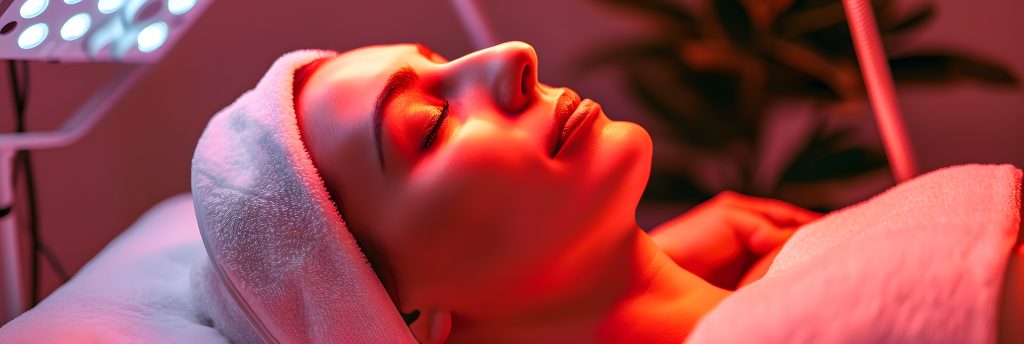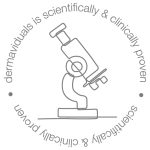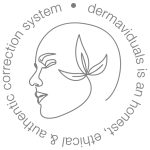
LED – Let there be light!
Light Emitting Diode (LED), is a non-invasive treatment that stimulates cellular regeneration and tissue homeostasis (balance) via the use of monochromatic (single wavelengths), and/or polychromatic (multiple wavelengths), using non-thermal nanometers of light. LED has been around for a very long time, and is used in many aesthetic and medical practices today to treat a variety of skin concerns such as Acne, Pigmentation, Rosacea and much more!
LED uses different nanometers or wavelengths of light which penetrate superficially and/or deep below the skin’s surface (depending on the nanometer), in order to stimulate an intracellular metabolic response within the cells environment, to improve the functioning of the integument and underlying immune system. This, in turn, increases energy production and supports tissue regeneration and homeostasis.
The immune system is composed of many different cells and systems that are required for the creation and operation of the skin barrier defence systems, which work together to create a healthy, glowing complexion.

As humans, our skin has the ability to absorb light, similar to the way plants undergo photosynthesis. For instance, plants create sugar molecules from sunlight, to synthesise cellular energy required for them to grow up big and strong – This is known as a photo-biochemical reaction i.e. Photosynthesis. The difference between plants and human skin is that plants do not get their sugar from eating food, unlike humans, so they need to make sugar from sunlight.
Human skin creates energy in the form of ATP (Adenosine Triphosphate) from the food we consume on a daily basis, and in terms of photosynthesis, has the ability of absorbing various light rays such as UVB from the electromagnetic spectrum, in order to generate Vitamin D3 within the tissue to maintain and support the immune system.
When using the correct non-thermal LED wavelength of light energy within the skin, amazing things can begin to unfold. LED light therapy uses a combination of different wavelengths which can enhance the skin’s cellular health over time. High quality LED devices are very sustainable as they operate to produce more light over time, while using less energy plus deliver a gentler application of treatment to the skin, as opposed to other skin treatment modalities available on the professional, and domestic market today.
LED works in tandem with the repair principles of Corneotherapy. Corneotherapy is a progressive and remedial skin treatment methodology, with its core principles being the repair, recovery and maintenance of the Stratum Corneum and its neighbouring defence systems at all times. This, in turn, ensures long-lasting and visible skin results overtime.
LED gently delivers precise doses of light energy into the skin’s tissue, simultaneously repairing collagen in the dermis, while gently undoing signs of ageing within the epidermis. The keratinocyte (main epidermal cell that works to build a functioning outermost layer of skin), plays a leading role in the ageing of the Epidermis, as it is responsible for generating important lines of cell barrier defence in order to protect the host from the outside environment.
LED works on improving the health of the Keratinocyte amongst other cells of the skin by working inside the cells factory (internal to cells). This, in turn, will bring on that healthy, glowing complexion as the skin barrier becomes stronger.
Let’s now explore LED wavelengths in a bit of detail…
Benefits of 415nm (Violet/Indigo):
- Purifying.
- Anti-bacterial, the ability to attack Acne causing bacteria by producing singlet Oxygen.
- Anti-inflammatory.
- Stimulates the production of Cytokines (signalling molecules our cells use to communicate with other adjacent cells).
- Supports wound healing.
- Phototherapy utilising a 415nm has been proven in the treatment of Acne Vulgaris and offers the skin treatment therapist an effective alternative, as opposed to Ablative peels and other accompanying modalities that impair skin barrier defence. In a study conducted, forty-five clients were treated with a 415nm where they underwent 2 treatments of 20 minutes per week for a period of 4-8 weeks. A thorough clinical assessment was performed at the baseline, as well as 2, 4 and 8 weeks after treatment. 9 clients experienced complete clearing at 8 weeks, with 50% of clients highly satisfied with a major reduction in their Acneic lesions.
So, how does this wavelength of light do this?
A 415 nanometer works on reducing the visible signs of Acne within the skin by means of interacting with a commensal bacteria called, “C.acnes,” by forming a singlet of Oxygen around this bacteria, and it is this bacteria that plays one of the leading roles in the development of Acne. The singlet of Oxygen created, encapsulates the bacteria and in turn, generates free radicals (unstable molecules) which ultimately leads to the breakdown of C.acnes in order to reduce the visible signs of Acne.

Benefits of 450nm (Blue):
- Stimulates intercellular communication.
- Increases cellular activity.
- Calming.
- Reduction of swelling.
- Muscle relaxer.

Benefits of 525nm (Green):
- Increases the formation of new Capillaries, while replacing damaged ones.
- Increased circulation and strengthening of the Capillary system.
- Increased Lymphatic system activity.
- Tyrosinase enzyme blocker (reducing the appearance of pigmentation).

Benefits of 590nm (Yellow):
- Supports the sensory and nervous systems.
- Toning and tightening muscles, aiding in the age-management process.
- Anti-bacterial.
- Lymphatic system stimulator i.e., detoxifying.
- Has been shown to decrease the intensity and duration of Erythema (diffused redness).

Benefits of 633nm (Red)
- The 633nm with a high-quality device is readily absorbed by tissues and cells, leading to enhanced skin health and cellular regeneration.
- The most effective to stimulate the dermal fibroblast cell to create new connective tissue i.e., Collagen, Elastin and Glycosaminoglycans such as Hyaluronic acid.
- Mitochondria ATP production (The energy required for our cells to function accordingly).

Benefits of 830nm (Near-infrared):
- The 830nm is designed to accelerate the wound healing process by decreasing excess inflammation that is damaging and impacting cell viability and repair.
- This wavelength is often used in the treatment of wounds, as cells exposed to near-infrared light from LED (830nm) grow 150 to 200 percent faster.

LED light can only be absorbed if the skin has balanced hydration levels! When the first three lines of skin barrier defence are not intact, and the skin is experiencing fast trans-epidermal water loss, it can be harder for the nanometres of light to penetrate the skin because the skin is not in homeostasis. LED wavelengths of light require a hydrated epidermis to be absorbed and utilised by the cells and systems for optimum results to be seen over a period.
A dry Stratum Corneum and compromised barrier defence systems will not support this skin treatment modality to its fullest potential!
So, what should you consider using on your skin if you want to get the most benefits of LED? dermaviduals of course!
If you want your skin to function accordingly, you need to be using a skin care system that works on a physiological cellular level. To repair, replenish and regenerate the first three lines of skin barrier defence. Dermaviduals unique delivery system consisting of Phosphatidylcholine (PC), has the ability of repairing the first three lines of skin barrier defence, in order to maintainbalanced hydration levels – Really important for the absorption of light!
LED was designed to be incorporated within our facial treatment services. It can be used stand-alone, but the best results are seen when incorporated within facial treatments.
To summarise, LED light therapy is a highly advanced skin treatment modality designed to support the operation and functioning of the skin barrier defence systems. Utilising various different non-thermal light energy wavelengths, LED works in unison with the repair principles of Corneotherapy to improve the quality of the skin and immune system over time. LED can be incorporated within facial treatment services and/or be used as a standalone service, however best results are seen when experiencing a Dermaviduals facial treatment.




